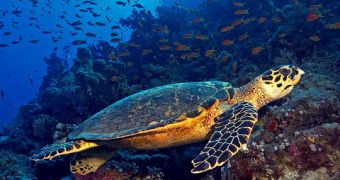Human-made chemical compounds are proven to have reached marine ecosystems, and scientists worry that five species of endangered sea turtles now run the risk of having their health affected by them.
The harmful substances taken into consideration by this study are perfluoroalkyl compounds, or PFCs for short, typically used by todays human society as stain-resistant coatings, fire-fighting foams and emulsifiers in plastics manufacturing.
Given the fact that said substances are now some of the world's most widespread pollutants, researchers from the Hollings Marine Laboratory and other green-oriented organization considered it necessary to have a look at how they influenced the well-being of marine ecosystems.
Special emphasis was placed on how five species of sea turtles respond to them, seeing how laboratory mice and fish have already been proven to develop liver, thyroid and brain conditions when exposed to these PFCs.
One of the scientists involved in this study explained how, in the end, he and his co-workers hoped to “get the first accurate measurements of the plasma blood concentrations of PFCs in five sea turtle species across different trophic levels, and then compare those concentrations to ones known to cause toxic effects in laboratory animals.”
Thus, they would be able to determine weather said turtles run the risk of going from being endangered to being extinct because of PFCs-related health issues.
End-results showed that species such as the hawsbills, the loggerheads and Kemp's ridleys do in fact have their blood contaminated with the aforementioned chemical compounds.
What is even more worrying is that the recorded concentrations are quite close to those that took their toll on the laboratory animals used in the first phase of the research.
As well as this, PFSs levels for all the five turtle species taken into consideration can be linked to immunity disorders.
Hopefully, this will urge environmental authorities to take immediate actions towards safeguarding the wellbeing of our oceans.
More information regarding this research is available on the NIST website.

 14 DAY TRIAL //
14 DAY TRIAL //